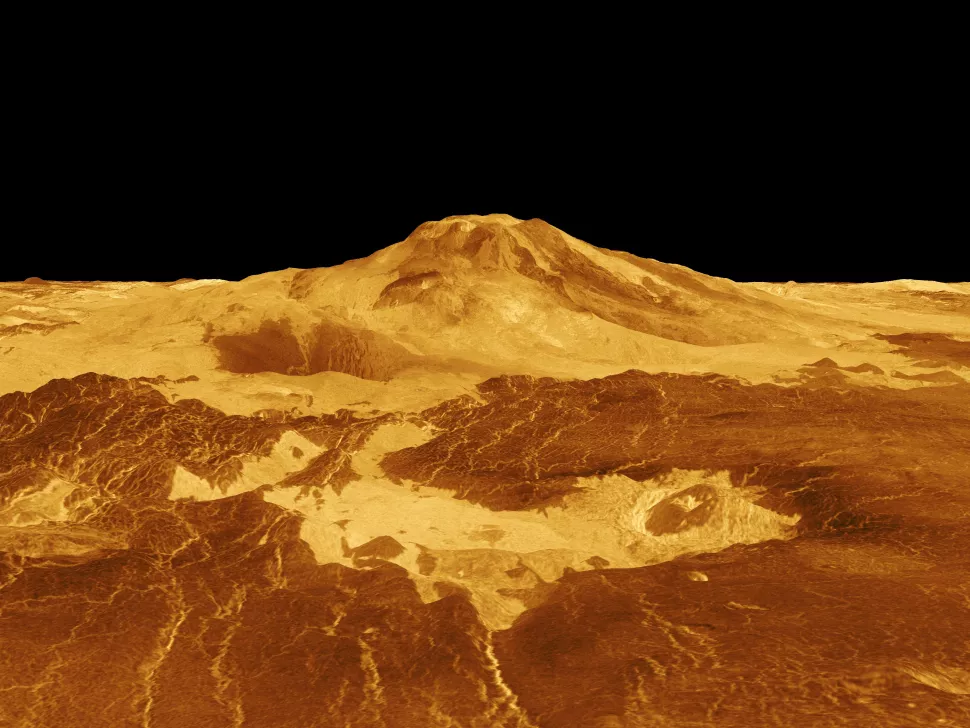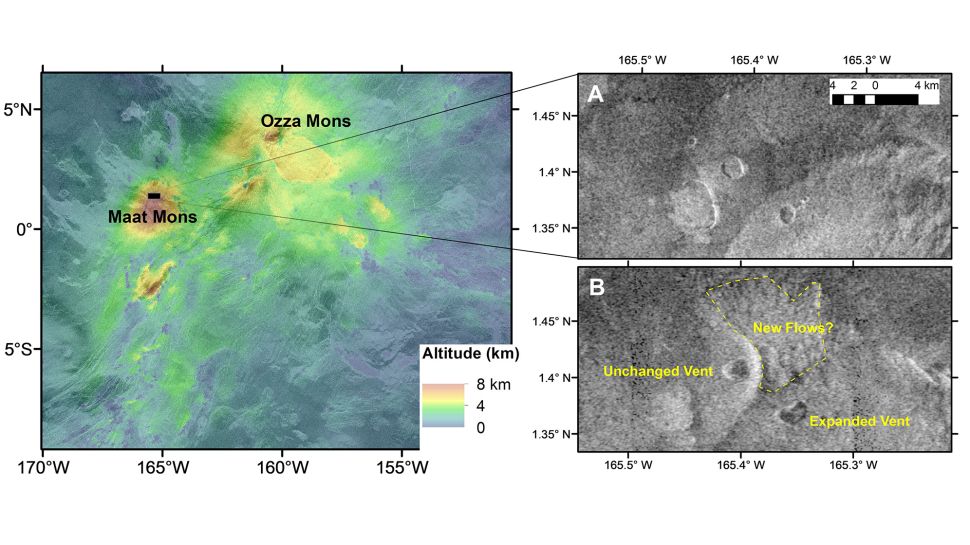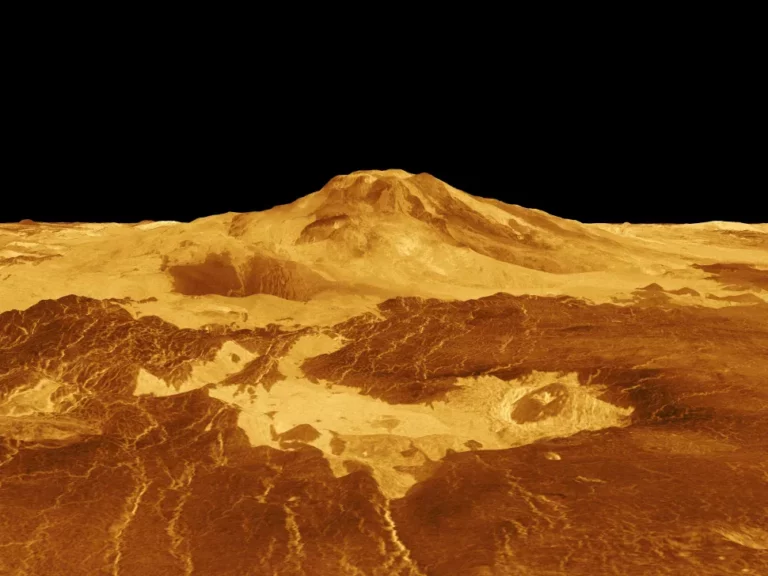An active volcano has been sighted on Venus, indicating that the planet is still geologically active and not completely lifeless.
And there could be many more on the blisteringly hot planet.
According to a recent paper published on Wednesday (March 15), scientists examining data transmitted by NASA’s Magellan spacecraft in the early 1990s have identified volcanic activity on Venus. The researchers observed changes in a vent located near Maat Mons, one of the planet’s largest volcanoes. At the 54th Lunar and Planetary Science Conference (LPSC), held both in Texas and online, Robert Herrick, a scientist at the University of Alaska Fairbanks Geophysical Institute, stated that the location of their discovery is the most probable site for new volcanic activity.
For a while now, scientists have been aware of lava flows on Venus, originating from volcanoes that erupted several million years ago. Although the planet boasts approximately 1,600 significant volcanoes and nearly one million smaller ones, the question of whether any of these volcanoes are still active has been widely debated.

The most recent discovery represents the first time that researchers have found clear-cut proof of recent volcanic activity on the surface of Venus, our neighboring planet. Scientists believe that such eruptions, which are less explosive than those on Earth, take place a minimum of a few times annually, further reinforcing the growing evidence that volcanoes play a crucial role in shaping the planet’s youthful surface.
In this recent study, researchers scrutinized two Magellan spacecraft images captured eight months apart in 1991. During that period, they noticed that a volcanic vent spanning 0.7 square miles (2 square kilometers) had grown “considerably larger” to roughly 1.5 square miles (4 square km).
During his presentation at LPSC, Herrick explained that the team observed a change in the shape of the volcanic vent, which was circular in the first image and kidney-shaped with a dark interior in the second. This is a sign of “a volcano that has erupted on the surface of Venus,” he stated. According to Herrick, the dark patch in the vent is probably a lava lake that has filled it to the rim.
Given the limited data available, the researchers speculate that the high pressure and extreme temperatures on Venus might result in runnier lava that flows for a more extended period than it does on Earth.
With Venus being predominantly covered in volcanoes, it is highly likely that there are many more active ones that remain undiscovered. While Herrick stopped searching after making this discovery, he emphasized that “by no means has all the potential searching for new stuff with the Magellan data been done.”
The most recent study only examines 1.5% of the planet, with approximately 40% being imaged by Magellan twice, providing scientists with a vast amount of radar images to sift through. Herrick pointed out that there are still several volcanoes on Venus similar to those in Hawaii that he did not have a chance to search, indicating that there is still plenty more work to be done.

A discovery from 30-year old data
In the early 1990s, NASA’s Magellan spacecraft took photos of Venus from orbit, revisiting the same spots every eight months for two years. These images were not taken with the intention of tracking surface changes, but have since provided valuable information to researchers. During the latest study, scientists noticed changes in a volcanic vent near Maat Mons, one of Venus’ largest volcanoes. The vent appeared circular in the first image but had changed to a kidney shape with a dark interior in the second image, providing evidence of recent volcanic activity. The dark interior was identified as a lava lake, suggesting that Venus’ high pressure and temperature make lava flow longer than it does on Earth.
The two images were taken at different angles, and researchers used a process called orthorectification to align points on the surface of Venus that remained constant in both images. This allowed them to convert the raw images into a format suitable for modeling. The discovery was made possible by recent advancements in software and hardware for planetary scientists, which allowed researchers to zoom in and out of the images and analyze large datasets. While the study covers just 1.5% of the planet, Magellan has imaged 40% of Venus twice, offering significant potential for future discoveries.
Is it really a volcano?
In order to verify if the researchers were indeed observing volcanic activity, Herrick collaborated with Scott Hensley, who is the project scientist for two of NASA’s upcoming Venus missions. Hensley expressed cautious optimism and excitement upon first observing the images, as previous attempts to detect similar changes in the photos had not yielded positive results. In addition, the images of many features on Venus appeared different in various Magellan photos, owing to differences in lighting and spacecraft angles.
“We wanted to be very careful here that we really had something,” Hensley stated.
To eliminate the possibility that the spacecraft angles alone were causing the observed changes, Hensley simulated hundreds of volcanic vents using data from Magellan about the vent’s shape, depth, and other attributes. The team outlined 60 of these vents in their new paper, which was published online on Wednesday in the journal Science.
Hensley stated that “none of our simulations could mimic the kidney shape of the vent” and that their simulations also did not produce a dark floor throughout the vent, as observed in the Magellan images. “That is what led us to very strongly believe we had a real change on the surface of Venus,” he added.
‘The decade of Venus’ likely to reveal more volcanic activity
NASA and Europe plan to send a fleet of spacecraft to Venus in the 2030s, which will include VERITAS and DAVINCI missions. DAVINCI will launch an atmospheric probe, whereas VERITAS and EnVision will observe the planet from orbit, looking for even minor surface changes.
These upcoming missions will provide a much more extensive dataset than what Magellan offered, which is currently the highest resolution data available. These missions will be free from the one-sided viewing issue that Magellan faced, making the data collection and analysis easier for scientists. Lori Glaze, Director of NASA’s Planetary Science Division, emphasized the importance of these missions for Venus studies.
The launch for DAVINCI is set for 2029, and VERITAS is scheduled to launch between 2032 and 2034, followed by EnVision between 2035 to 2039. The scientific community eagerly awaits the data to be collected by these upcoming missions.
Do not forget to share your opinion with us to provide you with the best posts !




0 Comments